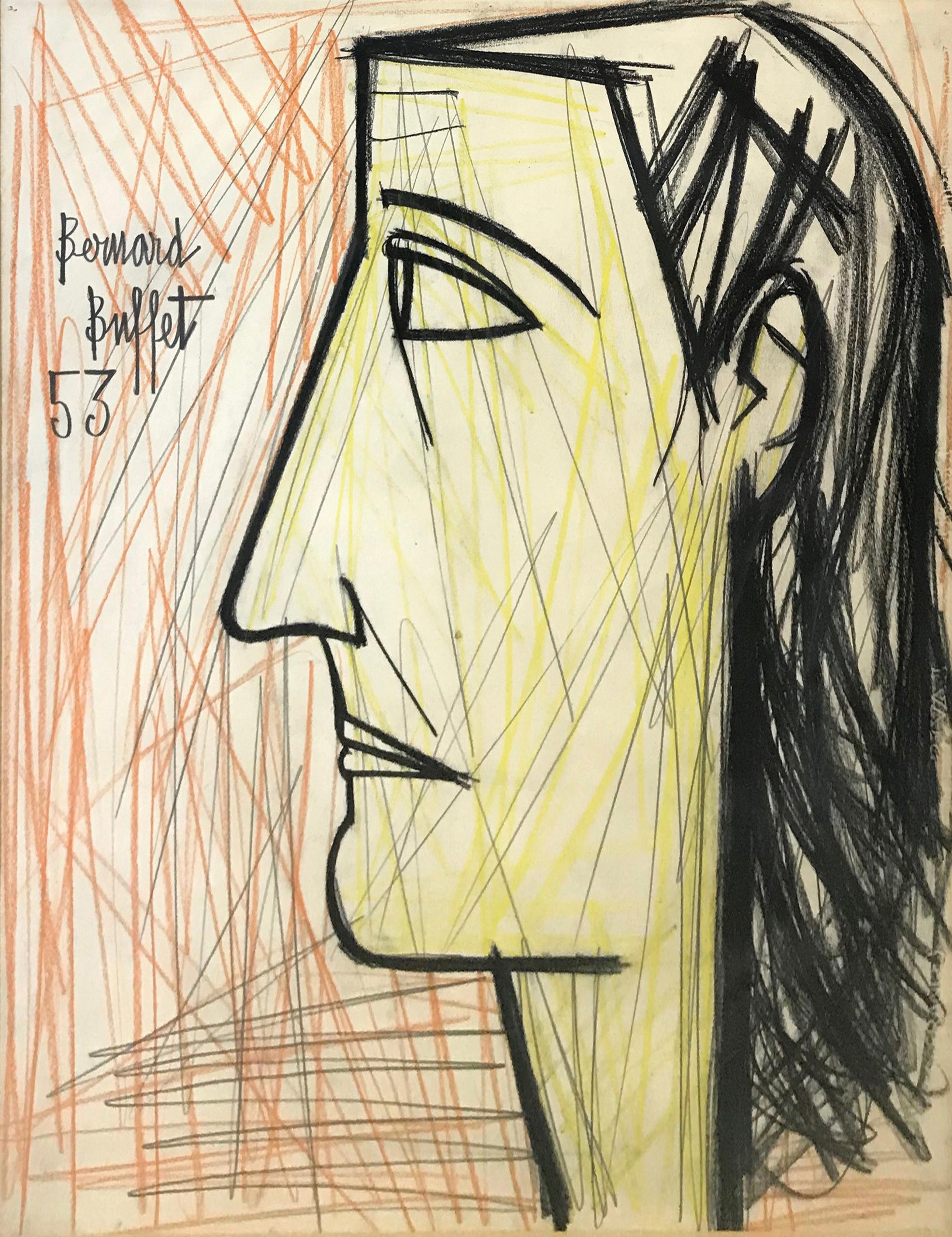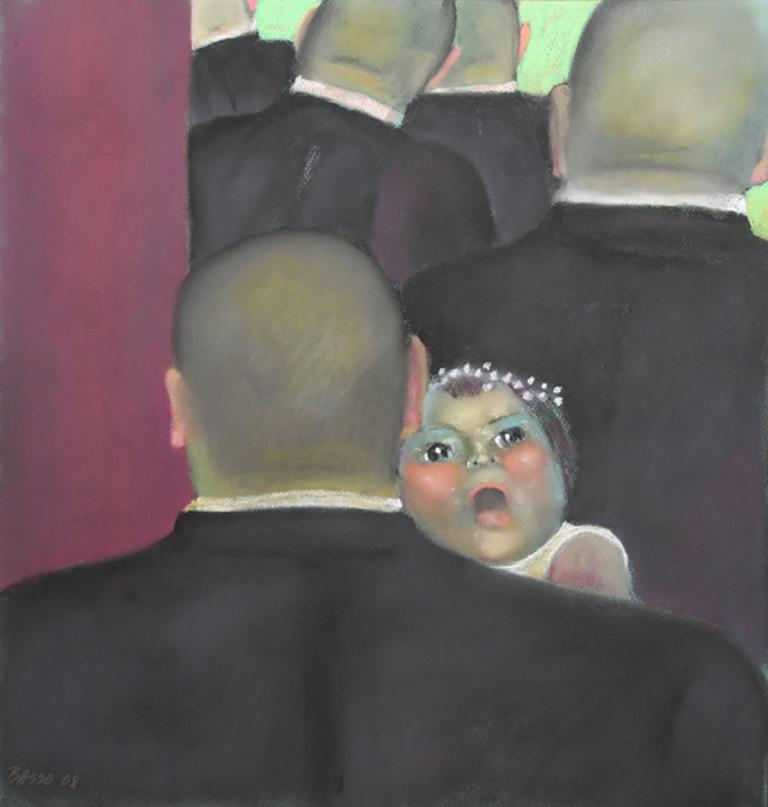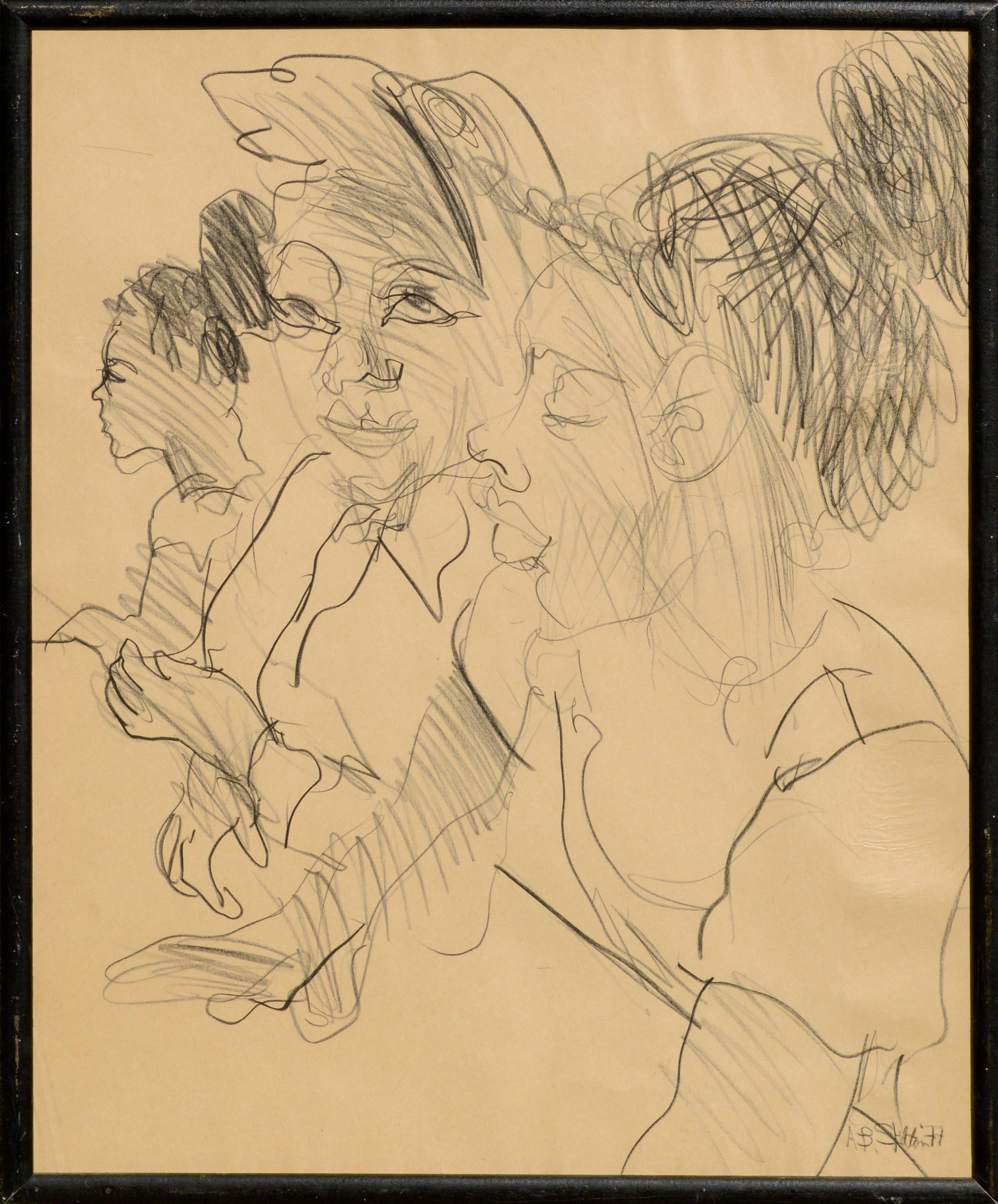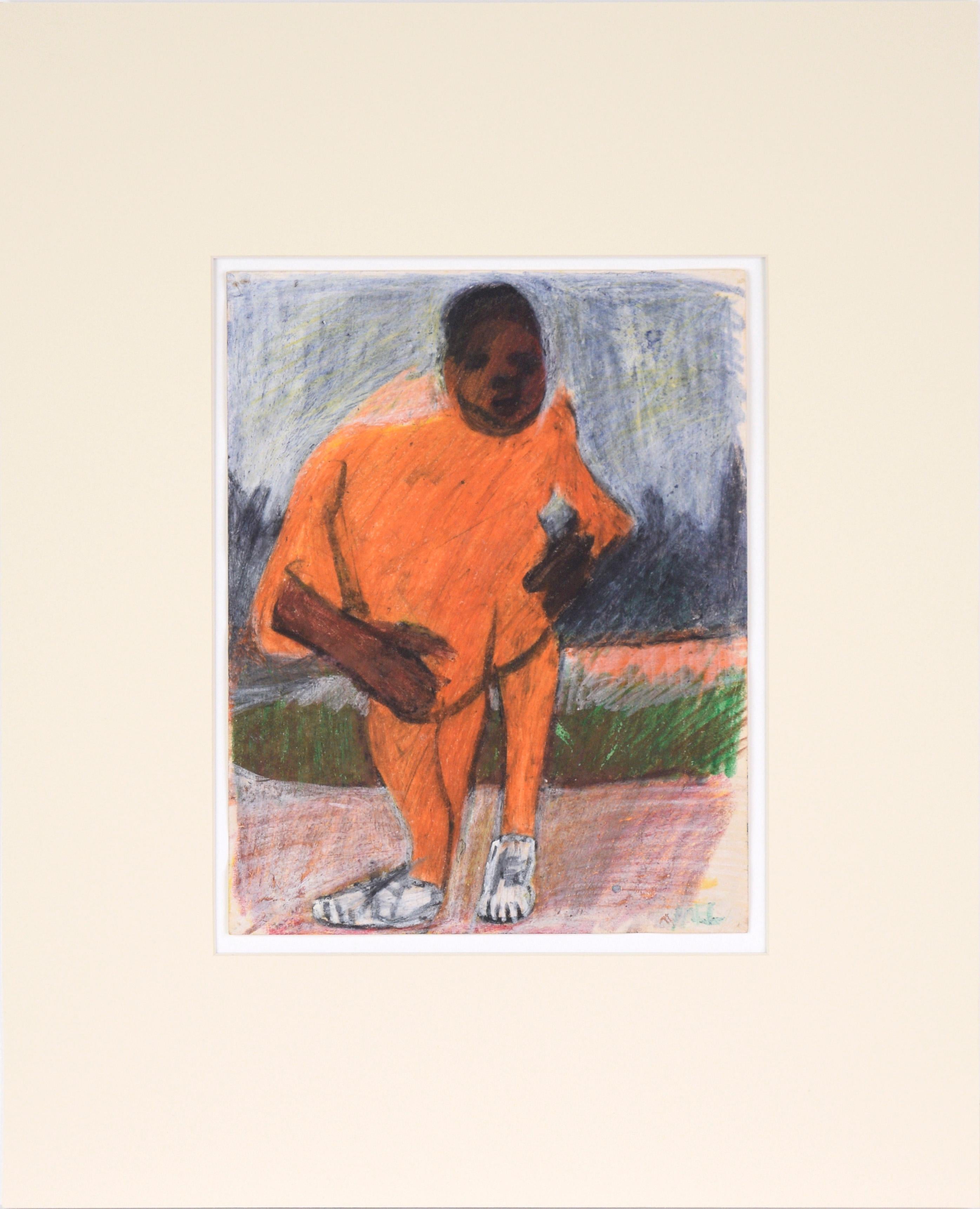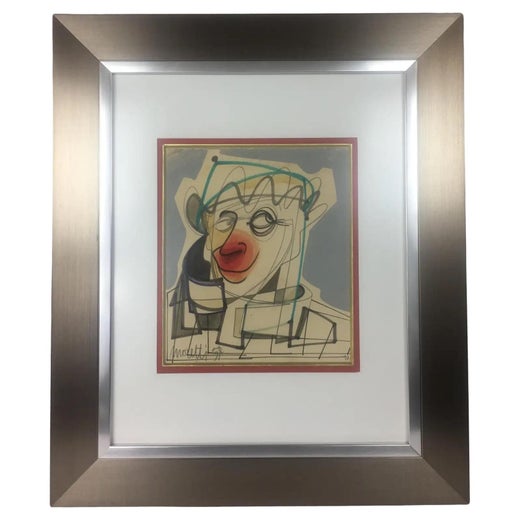Raymond MorettiFrench 20th Century drawing of Dancers at the Jazz club1960
1960
About the Item
- Creator:Raymond Moretti (1931 - 2005, French)
- Creation Year:1960
- Dimensions:Height: 17 in (43.18 cm)Width: 23.25 in (59.06 cm)Depth: 1 in (2.54 cm)
- Medium:
- Movement & Style:
- Period:
- Condition:Overall good condition, minor oxidisation to paper.
- Gallery Location:Petworth, GB
- Reference Number:1stDibs: LU54037202212
Raymond Moretti
Raymond Moretti was a French abstract painter. Born in Nice, France, on July 23, 1931, he made a living creating lithographs for posters, magazine covers and stamps. Deeply involved with jazz music, he had many famous musicians sit for him, including Ella Fitzgerald, Louis Armstrong and Thelonious Monk. In the 1960s, he illustrated covers for a series of 12 highly sought-after jazz LPs called Moretti Verve. Notably, he created the French Judicial Police logo, which combines the head of a man with the head of a tiger. Moretti died on June 3, 2005, in Paris, France.
- ShippingRetrieving quote...Ships From: Petworth, United Kingdom
- Return PolicyA return for this item may be initiated within 10 days of delivery.
- German Expressionist drawing by Carl Hofer of one of his modelsBy Carl HoferLocated in Petworth, West SussexCarl Hofer (German, 1875 – 1955) Das Modell (The artist’s model) Black crayon on paper Signed with monogram ‘CH’ (lower right) 18 x 14.1/8 in. (45.8 x 36 cm.) Provenance: These works come from the artist’s second wife Elizabeth and from then by descent. Carl Hofer was a German expressionist painter and the director of the Berlin Academy of Fine Arts. One of the most important painters of the Expressionist movement, his work was among those that was considered degenerate art by the Nazis. He studied in Karlsruhe under Hans Thoma. He first visited Paris in 1899 making acquaintance with Julius Meier-Graefe. In 1902 he studied in Stuttgardt and became friends with the sculptor Hermann Haller...Category
20th Century Expressionist Figurative Drawings and Watercolors
MaterialsCrayon, Paper
- German Expressionist drawing by Carl Hofer of a mother and childBy Carl HoferLocated in Petworth, West SussexCarl Hofer (German, 1875 – 1955) Mother and son Black crayon on paper 10.1/2 x 7.3/4 in. (26.7 x 20 cm.) With studio stamp (on the reverse) and signature of the artist’s wife Elizabeth Hofer Provenance: These works come from the artist’s second wife Elizabeth and from then by descent. Carl Hofer was a German expressionist painter and the director of the Berlin Academy of Fine Arts. One of the most important painters of the Expressionist movement, his work was among those that was considered degenerate art by the Nazis. He studied in Karlsruhe under Hans Thoma. He first visited Paris in 1899 making acquaintance with Julius Meier-Graefe. In 1902 he studied in Stuttgardt and became friends with the sculptor Hermann Haller...Category
20th Century Expressionist Figurative Drawings and Watercolors
MaterialsCrayon, Paper
- German expressionist drawing of bathers by Carl Hofer 'Die Badegasten'By Carl HoferLocated in Petworth, West SussexCarl Hofer (German, 1875 – 1955) Die Badegaste II (The bathers) Black crayon on paper 19.1/4 x 15 in. (49 x 38 cm.) With studio stamp (on the reverse) and signature of the artist’s wife Elizabeth Hofer Provenance: These works come from the artist’s second wife Elizabeth and from then by descent. Carl Hofer was a German expressionist painter and the director of the Berlin Academy of Fine Arts. One of the most important painters of the Expressionist movement, his work was among those that was considered degenerate art by the Nazis. He studied in Karlsruhe under Hans Thoma. He first visited Paris in 1899 making acquaintance with Julius Meier-Graefe. In 1902 he studied in Stuttgardt and became friends with the sculptor Hermann Haller...Category
20th Century Expressionist Figurative Drawings and Watercolors
MaterialsCrayon, Paper
- German Expressionist drawing by Carl Hofer of loversBy Carl HoferLocated in Petworth, West SussexCarl Hofer (German, 1875 – 1955) Die Liebenden (The lovers) Black ink and remnants of crayon on paper Signed with monogram ‘CH’ (lower right) 13.3/4 x 9.3/4 in. (35 x 24.8 cm.) P...Category
20th Century Expressionist Figurative Drawings and Watercolors
MaterialsCrayon, Paper, Ink
- German Expressionist drawing of abstracted figures by Carl HoferBy Carl HoferLocated in Petworth, West SussexCarl Hofer (German, 1875 – 1955) Abstract figures Pencil on paper 8.1/4 x 9 in. (21 x 23 cm.) With studio stamp (on the reverse) and signature of the artist’s wife Elizabeth Hofer Provenance: These works come from the artist’s second wife Elizabeth and from then by descent. Carl Hofer was a German expressionist painter and the director of the Berlin Academy of Fine Arts. One of the most important painters of the Expressionist movement, his work was among those that was considered degenerate art by the Nazis. He studied in Karlsruhe under Hans Thoma. He first visited Paris in 1899 making acquaintance with Julius Meier-Graefe. In 1902 he studied in Stuttgardt and became friends with the sculptor Hermann Haller...Category
20th Century Expressionist Figurative Drawings and Watercolors
MaterialsPaper, Pencil
- German expressionist drawing by Carl Hofer' Whispering'By Carl HoferLocated in Petworth, West SussexCarl Hofer (German, 1875 – 1955) Einflusterung (Whispering) Charcoal and pencil on paper Signed and inscribed ‘Einflusterung’ (lower middle) 17.1/4 x 13.3/8 in. (43.8 x 34 cm.) Provenance: These works come from the artist’s second wife Elizabeth and from then by descent. Carl Hofer was a German expressionist painter and the director of the Berlin Academy of Fine Arts. One of the most important painters of the Expressionist movement, his work was among those that was considered degenerate art by the Nazis. He studied in Karlsruhe under Hans Thoma. He first visited Paris in 1899 making acquaintance with Julius Meier-Graefe. In 1902 he studied in Stuttgardt and became friends with the sculptor Hermann Haller...Category
20th Century Expressionist Figurative Drawings and Watercolors
MaterialsPaper, Charcoal
- PROFIL DE FEMMEBy Bernard BuffetLocated in Aventura, FLOriginal pencil and crayon drawing on paper. Hand signed and dated on front by the artist. Visible image size 25.6 x 19.7 in. Frame size approx 32.25 x 27 in. Artwork is in excellen...Category
1950s Expressionist Figurative Drawings and Watercolors
MaterialsCrayon, Pencil, Paper
- cry in the wilderness a little girl consumed by griefBy Stephen BassoLocated in Brooklyn, NYSoft pastel on toned paper signed and dated by the artist depicting a small child being carried by relatives at what appears to be a funeral parlor.Category
Early 2000s Expressionist Figurative Drawings and Watercolors
MaterialsPastel, Archival Paper
- Expressionist Ink, Pastel, Crayon Drawing Jewish American Modernist Ben Zion WPABy Ben-Zion WeinmanLocated in Surfside, FLExpressionist ink and pastel crayon drawing of beans (carobs, flowers?) in pods Hand signed. Born in 1897, Ben-Zion Weinman celebrated his European Jewish heritage in his visual works as a sculptor, painter, and printmaker. Influenced by Spinoza, Knut Hamsun, and Wladyslaw Reymont, as well as Hebrew literature, Ben-Zion wrote poetry and essays that, like his visual work, attempt to reveal the deep “connection between man and the divine, and between man and earth.” An emigrant from the Ukraine, he came to the US in 1920. He wrote fairy tales and poems in Hebrew under the name Benzion Weinman, but when he began painting he dropped his last name and hyphenated his first, saying an artist needed only one name. Ben-Zion was a founding member of “The Ten: An Independent Group” The Ten” a 1930’s avant-garde group, Painted on anything handy. Ben-Zion often used cabinet doors (panels) in his work. Other members of group included Ilya Bolotowsky, Lee Gatch, Adolph Gottlieb, Louis Harris, Yankel Kufeld, Marcus Rothkowitz (later known as Mark Rothko), Louis Schanker, and Joseph Solman. The Art of “The Ten” was generally described as expressionist, as this style offered the best link between modernism and social art. Their exhibition at the Mercury Gallery in New York held at the same time as the Whitney Annual Exhibition of Contemporary American Painting, included a manifesto concentrating on aesthetic questions and criticisms of the conservative definition of modern art imposed by the Whitney. Ben-Zion’s work was quickly noticed. The New York Sun said he painted “furiously” and called him “the farthest along of the lot.” And the triptych, “The Glory of War,” was described by Art News as “resounding.” By 1939, The Ten disbanded because most of the members found individual galleries to represent their work. Ben-Zion had his first one-man show at the Artist’s Gallery in Greenwich Village and J.B. Neumann, the highly esteemed European art dealer who introduced Paul Klee, (among others) to America, purchased several of Ben-Zion’s drawings. Curt Valentin, another well-known dealer, exhibited groups of his drawings and undertook the printing of four portfolios of etchings, each composed of Ben-Zion’s biblical themes. He worked as a WPA artist. Ben-Zion’s work is represented in many museums throughout the country including the Metropolitan, the Whitney, and the Museum of Modern Art in New York, the Art Institute of Chicago, the Philadelphia Museum of Art and the Phillips Collection, Washington. The Jewish Museum in New York opened in 1948 with a Ben-Zion exhibition. Ben-Zion consistently threaded certain subject matter—nature, still life, the human figure, the Hebrew Bible, and the Jewish people—into his work throughout his life. "In all his work a profound human feeling remains. Sea and sky, even sheaves of wheat acquire a monolithic beauty and simplicity which delineates the transient as a reflection of the eternal. This sensitive inter- mingling of the physical and metaphysical is one of the most enduring features of Ben-Zion's works." (Excerpt from Stephen Kayser, “Biblical Paintings,” The Jewish Museum Catalogue, 1952). Mystical Imprints: Marc Chagall, Ben-Zion, and Ben Shahn presents the print work of three prominent 20th century Jewish artists born in the Russian Empire. Among these seventy pieces are etchings and lithographs from Chagall’s Bible series...Category
Mid-20th Century Expressionist Still-life Drawings and Watercolors
MaterialsPaper, Oil Crayon, Pastel, Ink
- Girls at the Lunch CounterBy Allie William SkeltonLocated in Soquel, CADrawing of three girls sitting at a counter by Allie William “Bill” Skelton (American, 1942-1986). Signed and dated "A B Skelton '77" in the lower right corner. Presented in a simple black wood frame with glass. Image size: 20"H x 16"W Allie William “Bill” Skelton (American, 1942-1986) was a painter and sculptor active in San Francisco who was involved in the gay art...Category
1970s Expressionist Figurative Drawings and Watercolors
MaterialsPaper, Pastel
- Expressionist Color Drawing Cobalt Glass Vintage Frame Modernist Ben Zion WPABy Ben-Zion WeinmanLocated in Surfside, FLExpressionist ink and pastel crayon drawing of flowers in vase. Framed in a vintage cobalt blue glass original frame Hand signed and dated Framed it measures 13.5 X 10.5 The actual paper is 7.5 X 5.5 Born in 1897, Ben-Zion Weinman celebrated his European Jewish heritage in his visual works as a sculptor, painter, and printmaker. Influenced by Spinoza, Knut Hamsun, and Wladyslaw Reymont, as well as Hebrew literature, Ben-Zion wrote poetry and essays that, like his visual work, attempt to reveal the deep “connection between man and the divine, and between man and earth.” An emigrant from the Ukraine, he came to the US in 1920. He wrote fairy tales and poems in Hebrew under the name Benzion Weinman, but when he began painting he dropped his last name and hyphenated his first, saying an artist needed only one name. Ben-Zion was a founding member of “The Ten: An Independent Group” The Ten” a 1930’s avant-garde group, Painted on anything handy. Ben-Zion often used cabinet doors (panels) in his work. Other members of group included Ilya Bolotowsky, Lee Gatch, Adolph Gottlieb, Louis Harris, Yankel Kufeld, Marcus Rothkowitz (later known as Mark Rothko), Louis Schanker, and Joseph Solman. The Art of “The Ten” was generally described as expressionist, as this style offered the best link between modernism and social art. Their exhibition at the Mercury Gallery in New York held at the same time as the Whitney Annual Exhibition of Contemporary American Painting, included a manifesto concentrating on aesthetic questions and criticisms of the conservative definition of modern art imposed by the Whitney. Ben-Zion’s work was quickly noticed. The New York Sun said he painted “furiously” and called him “the farthest along of the lot.” And the triptych, “The Glory of War,” was described by Art News as “resounding.” By 1939, The Ten disbanded because most of the members found individual galleries to represent their work. Ben-Zion had his first one-man show at the Artist’s Gallery in Greenwich Village and J.B. Neumann, the highly esteemed European art dealer who introduced Paul Klee, (among others) to America, purchased several of Ben-Zion’s drawings. Curt Valentin, another well-known dealer, exhibited groups of his drawings and undertook the printing of four portfolios of etchings, each composed of Ben-Zion’s biblical themes. He worked as a WPA artist. Ben-Zion’s work is represented in many museums throughout the country including the Metropolitan, the Whitney, and the Museum of Modern Art in New York, the Art Institute of Chicago, the Philadelphia Museum of Art and the Phillips Collection, Washington. The Jewish Museum in New York opened in 1948 with a Ben-Zion exhibition. Ben-Zion consistently threaded certain subject matter—nature, still life, the human figure, the Hebrew Bible, and the Jewish people—into his work throughout his life. "In all his work a profound human feeling remains. Sea and sky, even sheaves of wheat acquire a monolithic beauty and simplicity which delineates the transient as a reflection of the eternal. This sensitive inter- mingling of the physical and metaphysical is one of the most enduring features of Ben-Zion's works." (Excerpt from Stephen Kayser, “Biblical Paintings,” The Jewish Museum Catalogue, 1952). Mystical Imprints: Marc Chagall, Ben-Zion, and Ben Shahn presents the print work of three prominent 20th century Jewish artists born in the Russian Empire. Among these seventy pieces are etchings and lithographs from Chagall’s Bible series...Category
1950s Expressionist Still-life Drawings and Watercolors
MaterialsPaper, Oil Crayon, Pastel, Ink
- Track Star - Figurative Portrait of an African American Man in Pastel on PaperLocated in Soquel, CATrack Star - Abstracted Portrait of an African American Man in Pastel on Paper Bold and imaginative pastel drawing of a man in a track suit by an unknown artist (20th Century). An A...Category
Late 20th Century Expressionist Portrait Drawings and Watercolors
MaterialsPaper, Oil Pastel
